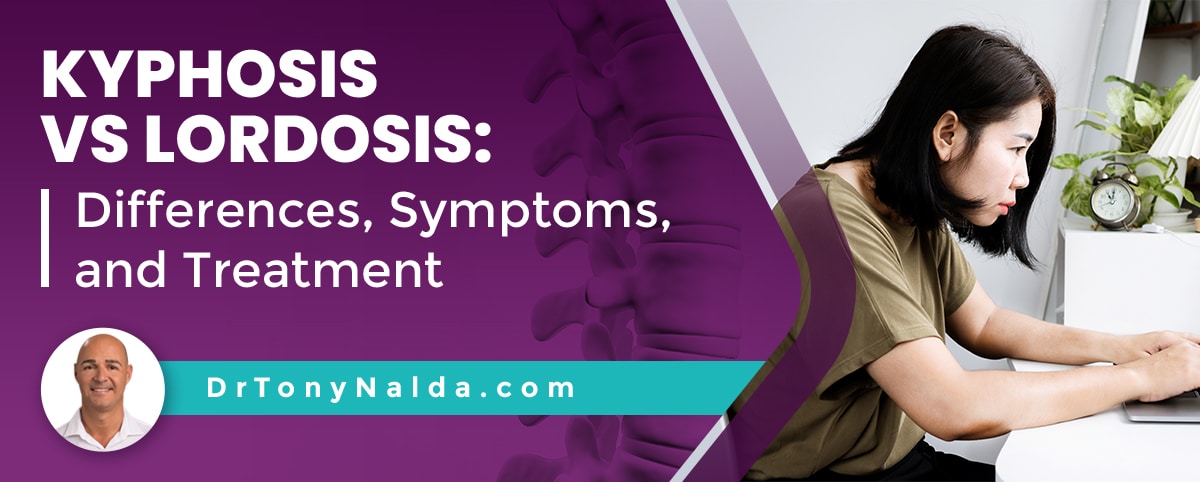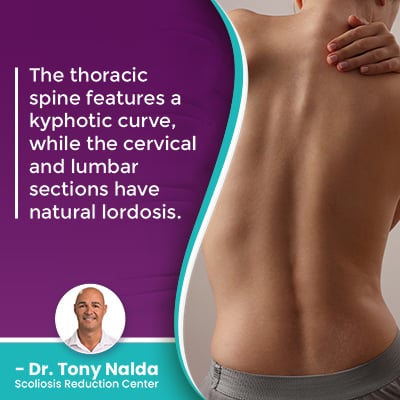Kyphosis vs Lordosis: Differences, Symptoms, and Treatment

When it comes to kyphosis vs lordosis, we’re talking about the spine’s curvature types that bend outwards, away from the body’s center, or inwards, towards the body’s center. When a person’s kyphosis or lordosis becomes excessive, it can be known simply as kyphosis and lordosis or hyperkyphosis and hyperlordosis.
For the spine to function optimally, it needs to maintain its natural curves/alignment. Kyphosis refers to the backward-bending curve of the thoracic spine, while lordosis refers to the forward-bending curve of the cervical and lumbar spinal sections. If these curves become excessive, problems occur.
Understanding the spine’s anatomy is helpful when exploring the role of the spine’s natural and healthy curves, so let’s start there.
Table of Contents
Anatomy of a Healthy Spine
A healthy spine helps us stand upright, practice good posture, move flexibly, and as the brain and spinal cord work together to form the central nervous system, effectively transmit signals/messages between the brain and the rest of the body.
The spine consists of vertebral bodies (bones of the spine) that are stacked on top of one another in a straight and neutral alignment, and when they are aligned, their natural curves are in place.
The spine’s healthy curves make it stronger, more flexible, and better able to absorb and distribute mechanical stress during activity.
In between adjacent vertebrae, there is an intervertebral disc, and the discs are key spinal structures that act as the spine’s shock absorbers, help with structure (adjacent vertebrae attach to the disc in between), enable flexible movement and provide cushioning so vertebrae don’t rub up against each other.
There are three main spinal sections, and each has its own characteristic curvature type: cervical spine (neck), thoracic spine (middle/upper back), and the lumbar spine (lower back).
So now that we’ve explored the structure of a healthy spine, let's move onto the different curvature types: kyphosis vs lordosis.
Kyphosis vs Lordosis
There are different types of spinal curves, and kyphosis refers to when the spine bends backwards, away from the body’s center, and lordosis refers to when the spine bends inwards, towards the body’s center.
 The thoracic spine features a kyphotic curve, while the cervical and lumbar sections have natural lordosis.
The thoracic spine features a kyphotic curve, while the cervical and lumbar sections have natural lordosis.
Now, if a person’s kyphosis in the middle/upper back becomes excessive, this can still be referred to simply as kyphosis or hyperkyphosis, and excessive lordosis is either referred to as lordosis or hyperlordosis.
There is a natural range of curvature sizes, measured in degrees, but if a patient’s curvature size falls beyond a normal range, problems can occur.
A natural and healthy range of thoracic kyphosis would fall between 20 and 40 degrees; an average range of cervical lordosis would be in the range of 20 to 40 degrees, while lumbar lordosis would fall within a range of 40 to 60 degrees.
So kyphosis vs lordosis refers to different curvature types, and as they involve different spinal curves and sections of the spine, they can cause different symptoms.
Kyphosis Symptoms
If a person is diagnosed with hyperkyphosis, there is an excessive backward-bending curvature of the middle/upper back, and the main symptom of hyperkyphosis is what’s referred to as a roundback appearance, and this is because is causes an excessively rounded-forward upper back and shoulders
While each case is unique and will produce its own unique symptoms, some common symptoms of hyperkyphosis can include:
- Fatigue
- Numbness and/or tingling in the lower body (legs)
- Breathing issues
- Changes to balance and/or coordination
- Bowel/bladder issues
For those with an exaggerated kyphotic curve, it takes more energy to hold oneself upright and maintain an economical gait, and this scoliosis can cause lethargy and fatigue.
Numbness and tingling can occur with nerve compression, and changes to balance and coordination can develop as a result of the condition’s uneven forces, and bowel/bladder issues are associated with severe cases.
Lordosis Symptoms
A diagnosis of hyperlordosis means a person has an excessive lordotic curve in the cervical or lumbar spine, and again, condition severity can range widely and cause different types of symptoms, and the most common symptom of hyperlordosis is a swayback appearance, as the buttocks and abdomen protrude excessively.
Some additional common symptoms of hyperlordosis can include:
- Back pain
- Muscle pain
- Sciatic nerve pain
- Being unable to lay flat on the floor with the lower spine also in contact with the floor
- Mobility issues
The loss of one of the spine’s healthy curves disrupt the biomechanics of the entire spine, which is why so many different symptoms are associated with spinal conditions.
Different symptoms are shaped by condition severity, curvature location, and the degree of nerve involvement.
So now that we’ve touched on the main differences between kyphosis and lordosis, and some common symptoms of each, let’s move on to treatment options.
Kyphosis Treatment
When it comes to treating kyphosis effectively, the first step is determining the condition type as it’s causation that has to shape the customization of treatment plans.
The two most common types of kyphosis are postural kyphosis and Scheuermann’s kyphosis.
Postural kyphosis is the most common and is a non-structural condition caused by chronic poor posture and lifestyle factors.
As the condition is non-structural, it doesn't involve a structural abnormality within the spine itself so is the simplest to treat with a combination of lifestyle guidance and physical therapy that increases core strength, improves posture, and brain-body communication.
 When it comes to Sheuermann’s kyphosis, we’re talking about a structural condition that’s not as simple to treat because there is a structural abnormality within the spine itself, so treatment as to, first and foremost, impact the spine on a structural level.
When it comes to Sheuermann’s kyphosis, we’re talking about a structural condition that’s not as simple to treat because there is a structural abnormality within the spine itself, so treatment as to, first and foremost, impact the spine on a structural level.
Condition-specific chiropractic care can help work towards repositioning the most-tilted vertebrae so they can be realigned with the rest of the spine, restoring a healthy range of kyphosis.
Physical therapy can help with increasing core strength so the spine is optimally supported by its surrounding muscles, improving posture, achieving a more natural body position, and facilitating brain-body communication.
Unnatural spinal curves tend to get worse over time, particularly if left untreated, so the best time to start treatment is always now.
Lordosis Treatment
When it comes to excessive lordosis, this can be caused by chronic poor posture, carrying excess weight, leading a sedentary lifestyle, or the presence of an underlying spinal condition.
Once the cause is determined, treatment plans can be created to address key patient/condition variables.
When poor posture is determined as the cause, this is because, over time, when the body and spine is held in an unnatural position, it can disrupt the spine’s natural curves and alignment, so postural remodeling through condition-specific exercises and physical therapy can help.
The spine’s design is based on movement, so not maintaining a healthy activity level can affect the spine’s surrounding muscles that become weak and can’t support the spine optimally.
A lot of sitting also tends to mean holding the body in an unnatural position that, again, over time, can introduce adverse spinal tension and affect the position and alignment of the spinal vertebrae.
Staying active keeps the spine and its surrounding muscles as loose, flexible, and strong as possible, and practicing healthy posture means the spine is always held in a natural and healthy position.
Introducing an exercise regime and providing lifestyle guidance can help address kyphosis caused by carrying excess weight, as particularly for those with excess weight in the buttocks and abdomen area, this can add excess strain on the lower back and its surrounding muscles; weight loss can help address the issue.
When an underlying spinal condition such as discitis, spondylolisthesis, or hyperkyphosis (compensatory curves) is the underlying cause of developing an excess degree of lordosis, the spinal condition has to be treated proactively as it’s the cause of the unnatural spinal curve.
Here at the Scoliosis Reduction Center, I’ve treated a wide range of spinal conditions, kyphosis and lordosis included, and the first step is always determining the condition’s underlying cause.
Conclusion
In order for the spine to function as it was designed, it needs to have its natural curves and alignment in place and experience a healthy level of activity to keep it, and its surrounding muscles, as strong and flexible as possible.
There are a number of spinal conditions a person can develop that involve a loss of its healthy cures, and kyphosis involves the development of an excessive kyphotic curve in the thoracic spine, and lordosis is the development of excessive lordotic curve in the cervical and/or lumbar spinal sections.
There is a natural range of kyphosis and lordosis, but if a person’s curvature degree falls beyond a normal range, this disrupts the biomechanics of the entire spine, introducing uneven forces to the spine, its surroundings, and the entire body.
Once a condition’s underlying cause is determined, treatment plans can be shaped around it to effectively impact the condition on every level.
The two most common types of kyphosis are postural and Scheuermann’s, and lordosis is most commonly caused by lifestyle factors such as poor posture, carrying excess weight, and/or the presence of an underlying spinal condition.
The goal of treatment is always to restore as much of the spine’s natural curves as possible, and for structural conditions, this involves condition-specific chiropractic care, and physical therapy can help work towards increasing core strength and spinal flexibility, and lifestyle guidance can involve facilitating healthy activity levels, weight loss, and postural remodeling.
Dr. Tony Nalda
DOCTOR OF CHIROPRACTIC
After receiving an undergraduate degree in psychology and his Doctorate of Chiropractic from Life University, Dr. Nalda settled in Celebration, Florida and proceeded to build one of Central Florida’s most successful chiropractic clinics.
His experience with patients suffering from scoliosis, and the confusion and frustration they faced, led him to seek a specialty in scoliosis care. In 2006 he completed his Intensive Care Certification from CLEAR Institute, a leading scoliosis educational and certification center.
About Dr. Tony Nalda
 Ready to explore scoliosis treatment? Contact Us Now
Ready to explore scoliosis treatment? Contact Us Now





